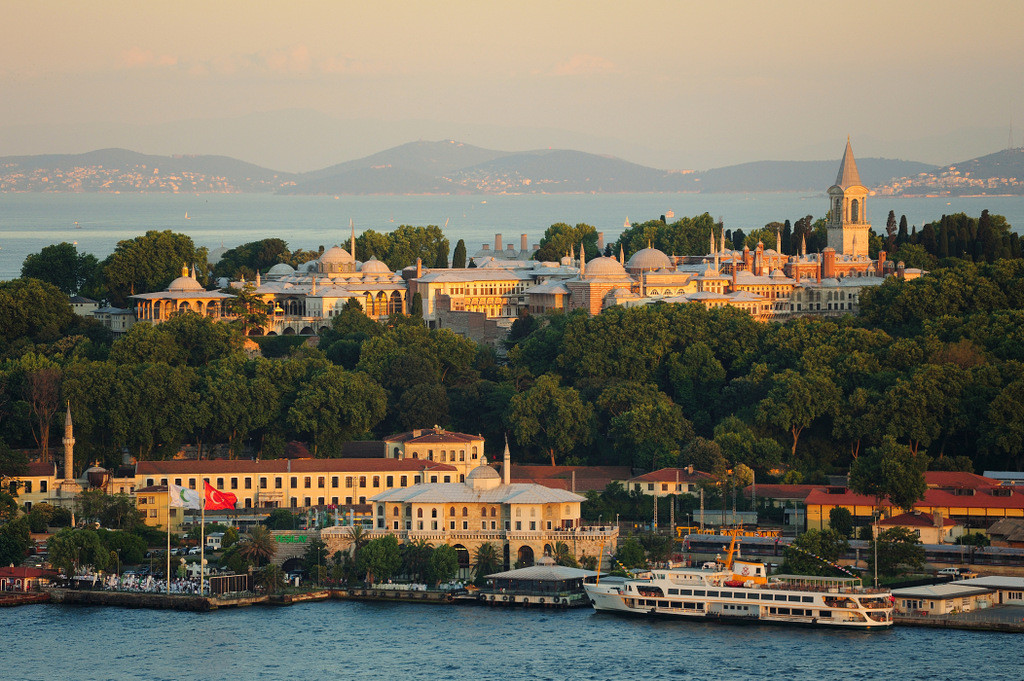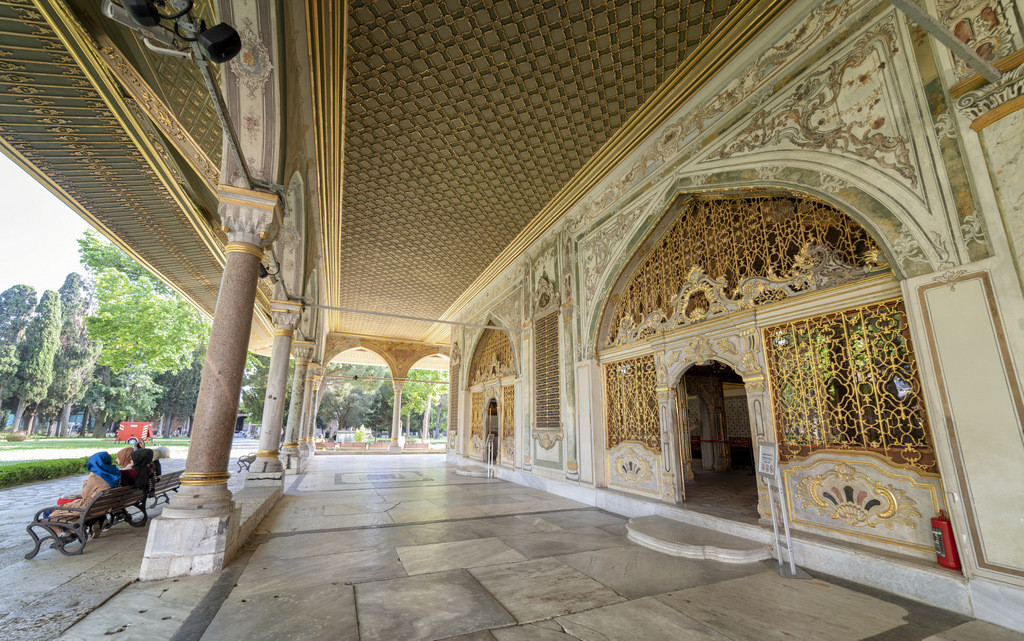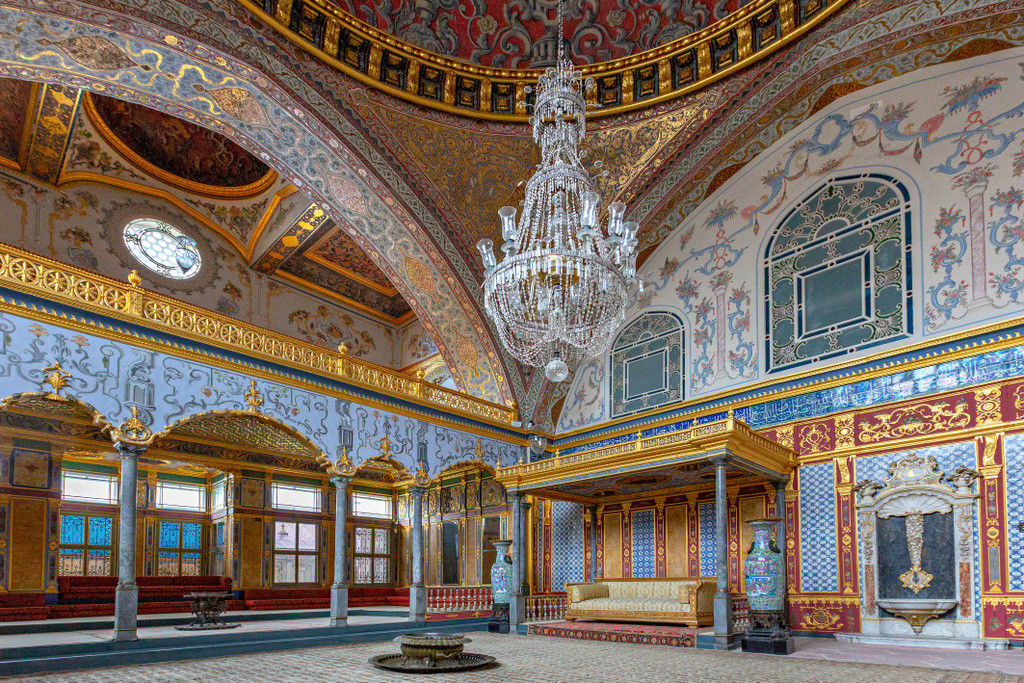Where power once wore silk robes and whispered behind golden screens, Topkapi Palace rises like a dream of empire. For nearly 400 years, this sprawling complex served as the beating heart of the Ottoman dynasty — a city within a city, veiled in ceremony, secrecy, and splendor. From jeweled daggers to shadowy courtyards, it holds stories not only of sultans, but of eunuchs, concubines, and grand viziers who shaped the fate of a continent.
Topkapi Palace entrance fee in 2026 is 2750 Turkish Liras. The Istanbul Museum Pass is valid for this site. Visiting hours are from 09:00 in the morning until 17:00 in the evening. (Information last reviewed on January 2, 2026 — see more details in the dedicated sections below.)
If you’d like to secure a skip-the-line ticket for Topkapi Palace, you can 👆
book your fast-track admission ticket here
. This way, you can bypass long ticket queues, especially during the busy spring and summer season.
Throughout the rest of this guide, you’ll find clear and practical tips to plan your visit. Having worked as a professional tour guide in Istanbul for more than two decades, I’ve gathered here the most frequent questions from my guests — along with straightforward answers that will help you enjoy Topkapi Palace more smoothly and make the most of your time inside its walls.
📌 Topkapi Palace 2026 Visitor Summary
A practical guide to visiting Topkapi Palace in 2026 — updated ticket prices, hours, and quick tips.
🏷️ Ticket Price: 2750 TL (approx. €55) for tourists — includes both Palace and Harem
⏰ Opening Hours: 09:00 – 17:00
🙏 Closed: Tuesdays
⏳ Average Visit Duration: Around 3 hours
🎫 Museum Pass: Valid for both Palace and Harem
🚀 Skip-the-line: Online tickets recommended (booking link below)
📍 Location: Sultanahmet, Istanbul
📅 Last Updated: January 2026
History of the Topkapi Palace
The history of Topkapi Palace goes back 550 years, to the rise of the Ottoman Empire. It was built by Sultan Mehmed after the conquest of Istanbul by the Ottomans and remained the residence of the Sultans for nearly 400 years.
When the Ottomans captured Constantinople (in 1453), they realized that the condition of the buildings in the city was not good. The city never returned to its former glory after being sacked in the Fourth Crusade in 1204. The most important monuments of the city, such as the Great Palace, Hagia Sophia and Hippodrome, were in poor condition.
In 1204, the Crusaders led by the Duke of Venice sacked Constantinople and established a Latin Empire there. The Byzantines recaptured the city 57 years later in 1261. However, due to financial reasons, it was not possible to fully restore the city.
1. Sultan Mehmed the Conqueror

Sultan Mehmed was one of the best educated sultans in Ottoman history. When he conquered Istanbul, he was aware of the history of the city. According to Turkish historians, the first thing he did after the fall of the city was to see Hagia Sophia, which he was very curious about.
Sultan Mehmed, who watched the city from the roof of Hagia Sophia, was saddened by the neglected Great Palace. The Great Palace of Constantinople, where great emperors like Constantine and Justinian lived, had already become ruin. Due to this state of the Great Palace, the Byzantine emperors lived in the Palace of Blachernae in the last years of the empire.
2. Construction of the Old Palace
Sultan Mehmed first built a palace where today’s Istanbul University (and the Grand Bazaar) is located. This place, called the Old Palace, was the place where the sultan lived while the Topkapi Palace was under construction.
The Topkapi Palace (can be seen in the picture above) was built on the ruins of the Byzantium, the Greek acropolis, which was the pre-Roman settlement of the city.
3. The Harem Wasn’t Here Before
The Ottomans built the palace between 1461 and 1478. The architecture of the palace resembles a castle and contains all the buildings a small city needs. Sultan Mehmet built Topkapi Palace to work, relax and carry out state affairs. For this reason, there was no Harem section in the main plan of Topkapi Palace. The Harem moved to the Palace much later in the middle of the 16th century.
Although Topkapi Palace was a place where 25 sultans lived during the most powerful period of the Ottoman Empire, it draws attention with its simplicity. Visiting the Topkapi Palace offers views of the Bosphorus and plenty of outdoor walking.
Things to See in Topkapi Palace
Topkapi Palace is a complex consisting of four large courtyards. It has a very different architecture from European palaces. The most important historical monument to be seen in the first courtyard is Hagia Irene, a former Byzantine church.
After passing this beautiful church you will see the ticket offices on the right. After purchasing the Topkapi Palace tickets, you can enter the palace through the gate, which is surrounded by two big towers.
1. Divan-ı Humayun (Imperial Council)

The Imperial Council consists of two rooms. One of these rooms carries traditional Turkish decoration with blue tiles and pencil works. The neighboring room was damaged in a fire and rebuilt. The restoration was carried out during the period when the Ottoman Empire was under French influence. Therefore, it carries the inspiration of western architecture.
2. Collection of Clocks and Weapons
Next to the Imperial Council rooms there is a Collection of Clocks that were presented to the Ottoman sultans. And next to the Clock Room a Collection of Weapons with centuries-old swords and rifles can be seen.
3. Palace Kitchens
On the opposite side of the courtyard is the palace kitchens. You can see the traces of two different periods in Ottoman palace life in palace kitchens. In the early period of the Ottoman Empire, Chinese porcelain was used on the ground table, while in the late period there was a western table setting.
4. Topkapi Palace Harem Rooms

The entrance to the Harem is located in the Second Courtyard, right beside the Imperial Council (Divan-ı Hümayun). Because parts of the Harem have been under ongoing restoration for many years, the internal walking route often changes. This is not accidental: the Harem was never part of the original design of Topkapi Palace and was gradually added over time, which explains its compact layout and maze-like structure today.
When Sultan Mehmed II first built Topkapi Palace, he intended the imperial Harem to remain in the Old Palace in the city. It was only later, during the reign of Suleiman the Magnificent, that the Harem was moved into Topkapi Palace — a decision closely associated with Hürrem Sultan (Roxelana). This shift not only reshaped the palace itself but also marked a turning point in the inner life of the Ottoman court.
5. Audience Hall
State affairs during the Ottoman period were discussed in the Divan (Imperial Council). These meetings were chaired by the Grand Vizier.
The issues discussed in the meetings that took place almost every day of the week were conveyed to the sultan in the Audience Hall. This is the first section you will see in the third courtyard of Topkapi Palace.
6. The Library

The library is located in the middle of the third courtyard of the palace. When you exit the Audience Hall, the building in front of you is the library built by Ahmed III.
The library bears the traces of Classical Ottoman architecture and is decorated with Ottoman tiles, pencil works, mother-of-pearl and oriental carpets. Since the books in the library are under protection, there are a few symbolic books inside.
7. Sacred Relics
When you start to tour the third courtyard clockwise, you will first see the Portraits Section on the left. Here you can see hundreds of years old portraits of sultans. The most interesting part of the courtyard, especially for Muslim visitors, is the room with Sacred Relics. This room contains belongings of the Prophet Muhammad.
8. Imperial Treasury
The most visited section in Topkapi Palace is the Imperial Treasury where the jewels are exhibited. This is where the most valuable objects such as Spoonmaker’s Diamond and Topkapi Dagger are located.
The Treasury Section consists of four rooms and houses hundreds of objects. This section was reopened with a completely renewed exhibition layout after being renovated for 8 years between 2015 and 2023. The new sections of the treasury look great.
9. Mecidiye Pavilion
When you leave the Treasury Room you can go to the next courtyard. The most beautiful part of the fourth and last courtyard is where the Mecidiye Pavilion was built in the 19th century. Here you can photograph the magnificent view of the Bosphorus.
This mansion was closed to visitors for many years. However, as of 2026, you can now see the 19th century Ottoman decoration inside this baroque building. This part of the palace resembles the Dolmabahce Palace in its westernized form.
10. Baghdad Pavilion

In the northern part of the fourth courtyard with a view of the Golden Horn, there are the Baghdad and Revan pavilions. From the balcony of the Baghdad Pavilion, you can watch the view as the sultans once did.
The interior decoration of the Baghdad Pavilion (can be seen in the picture above) is one of the last works before the Ottomans switched to western architectural style.
The interior decoration of Baghdad Pavilion is a magnificent blend of Arabian, Persian and Turkish architecture.
Topkapi Palace Entrance Fee (2026)
Topkapi Palace entrance fee is 2750 Turkish Liras in 2026. This all-inclusive ticket grants access to the main palace complex, the Harem section, and the Hagia Irene Church. Please note that Museum Pass Istanbul is valid for all sections of the palace. This information was last updated on January 2, 2026.
🎟️ Skip the Line at Topkapi Palace
Don’t want to wait in long lines at the entrance of Topkapi Palace? Here are two great options! You can either explore at your own pace with an audio guide, or join a guided small group tour that includes both the palace and the Harem section.
No waiting • Mobile tickets • Instant confirmation • Great reviews
Topkapi Palace Opening Hours (2026)
In 2026, Topkapi Palace is open daily from 09:00 AM to 5:00 PM, except on Tuesdays, when it is closed to visitors. This information was last updated on January 2, 2026.
There may be changes in the entrance hours of the museums in Istanbul. Before going to the museum, I recommend you to visit the official website of the palace and review the latest situation.
How to Get to the Topkapi Palace?

Topkapi Palace sits majestically at the tip of Istanbul’s Historic Peninsula, right next to two of the city’s most iconic landmarks: Hagia Sophia and the Blue Mosque. It’s nestled at the edge of Sultanahmet Square, with its main entrance—known as the Imperial Gate (Bab-ı Hümayun)—located just across from the Hagia Sophia’s courtyard and fountain area.
If you’re already in Sultanahmet, you’re just a few steps away. The entire area is pedestrianized, so simply follow the stream of visitors moving between the Hagia Sophia and Blue Mosque. Look for the high stone walls and the grand gate crowned with a golden inscription—that’s the main entrance to Topkapi Palace. You’ll also find directional signs marked “Topkapi Sarayi” (its name in Turkish) throughout the square.
To reach the palace from Taksim Square, take the F1 Funicular down to Kabataş. From Kabataş station, board the Tram T1 heading toward Bağcılar and get off at Sultanahmet (about a 15–20 minute ride). As you exit the tram, walk toward Hagia Sophia—it will appear straight ahead with its massive dome. Once you’re in the main plaza, Topkapi Palace will be to your left. Walk past Hagia Sophia’s garden and you’ll soon arrive at the grand entrance gate of the palace complex.
Whether you’re walking through Sultanahmet’s historic cobblestone alleys or arriving by tram, the path to Topkapi Palace is both intuitive and scenic. Along the way, you’ll be flanked by centuries of history and surrounded by domes, minarets, and blooming gardens—setting the perfect stage for what awaits inside the palace walls.
Then make sure to visit these other historical treasures nearby — each one offering a unique glimpse into Istanbul’s layered past:
- Hagia Sophia – A timeless marvel that bridges empires and faiths
- Basilica Cistern – Istanbul’s eerie and beautiful underground wonder
- Dolmabahce Palace – A dazzling 19th-century palace on the Bosphorus
- Blue Mosque – An iconic masterpiece of Ottoman architecture and faith
- Galata Tower – Enjoy breathtaking views of Istanbul from above
Conclusion
Topkapi Palace isn’t just a museum — it’s a living archive of imperial dreams, secrets, and splendor. As you wander through its courtyards, chambers, and terraces, you’re not simply looking at artifacts — you’re stepping into the rhythm of a vanished world.
After visiting the palace, consider walking downhill through Gulhane Park — once the private garden of the sultans. It’s a peaceful green path that leads you to the Istanbul Archaeological Museums, another treasure trove just next door.
From there, head to Sultanahmet Square to explore the Blue Mosque or Basilica Cistern, both within five minutes on foot. Or follow the scent of spice and roasted nuts down to Eminönü, where the Grand Bazaar and Spice Bazaar open their colorful arms to curious wanderers.
Whether you’re a history buff or just soaking up the magic of Istanbul, Topkapi Palace is the perfect place to begin — or end — your journey through the Old City.
Written by Serhat Engul
I am planning a trip for my son and his friends and I am using your articles. They are so informative and up-to-date. Thank you so much.
Dear Ann-Marie Thornton,
Thanks for your kind words about the blog. It makes me happy that my content is useful for those planning a trip to Istanbul.
Have a nice trip!
Hello Serhat
Thank you for creating this blog. Do you know if a ticket is required for children under 6 (even if it is free) or they can go in without ticket just accompanied by an adult with ticket?
Hello Macario, yes, as far as I know, entrance is free for children under 6 years old. If you show the child’s passport to the officer at the box office when you buy a ticket, they will give a free pass for the child.
Thanks a lot, Serhat for your blog. Really liked the information. I see that in some sites, there is a mention that students have a discounted rate which even international students can avail. I am travelling to Instanbul with my kids. Can you shed some light on that?
Thanks,
Masoud A R.
Dear Masoud, as far as I know, entrance to Topkapi Palace is free for children under the age of 7. However, I’m not 100% sure as the rules on this subject can change from year to year.
Other than that, I don’t think there is a discount for foreign students. Student discount is only available for Turkish citizens, with the exception of a few private museums (e.g. Istanbul Modern).
I want to know whose telling the truth! Museum in England and You both claim to have the Staff of Moses.
There is no need to seek scientific certainty in matters of faith. There are many churches in the world that claim to have the true cross. The same goes for the relics of saints. Whatever you believe in matters related to religion is the truth for you.
Topkapi is a really beautiful place! thank you for this article <3
Hi Susan, thank you for the feedback.